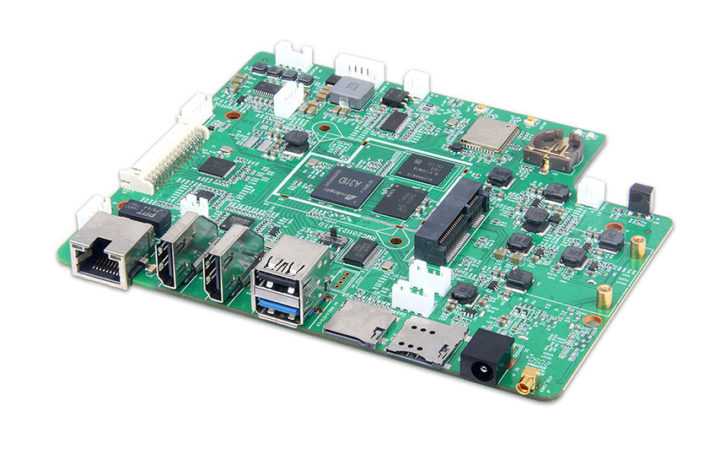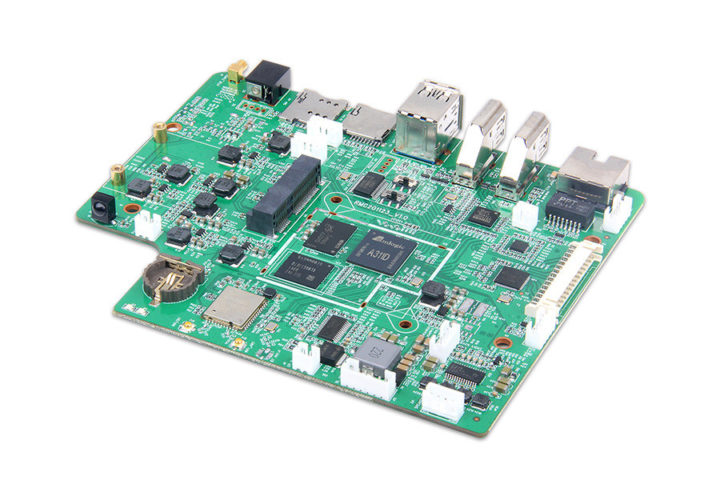Amlogic A311D hexa-core Cortex-A73/A55 AI processor has found its way into a limited number of platforms including Khadas VIM3 SBC, Zora P1 development board for Orbbec 3D cameras, as well as the upcoming Jevois Pro AI camera.
Another development board that takes advantage of the Amlogic A311D processor is Geniatech DB10 which ships with up to 4GB LPDDR4, up to 64GB eMMC flash, and offers interesting features like a digital TV tuner, HDMI input, support for 3G/4G modems, and more.
 Geniatech DB10 specifications:
Geniatech DB10 specifications:
- SoC – Amlogic A311D hexa-core processor with quad-core Arm Cortex-A73, dual-core Arm Cortex-A53 processor, Arm Mali-G52 MP4 (6EE) GPU with OpenGL ES 3.2, Vulkan 1.0 and OpenCL 2.0 support, 5 TOPS NPU
- System Memory – 2GB LPDDR4 (4GB optional)
- Storage – 16GB eMMC flash (8 to 64GB optional)
- Video
- Output
- HDMI 2.1 up to 4Kp60
- Dual-channel LVDS (shared with eDP) via 30-pin connector
- Input
- HDMI input up to 1080p60
- 2x MIPI CSI interface for cameras: 1x 4-lane MIPI CSI, 1x 2-lane MIPI CSI
- Output
- Tuner – Optional DVB-T2/T/C, ATSC 1.0/3.0, ISDB-T or DTMB digital TV tuner
- Audio – Speaker and microphone headers, digital audio output/input via HDMI ports
- Connectivity
- Gigabit Ethernet port with 802.at PoE support
- Dual-band 802.11 a/b/g/n/ac WiFI 5 (2.4GHz/5GHz)
- Bluetooth 4.2 (Optional Bluetooth 5.0)
- Optional 3G/4G LTE modem via mPCIe socket and
- USB – 1x USB 3.0 port, 3x USB 2.0 interfaces including one USB 2.0 Type-A port, and two via headers
- Serial – 2x serial interfaces: 2-wire UART plus 2-wire UART/debug
- Misc – Watchdog & RTC with backup battery, IR receiver
- Power Supply – 12V/2A via DC jack
- Dimensions – 142 x 117 mm
- Certifications – CE/FCC
 Geniatech provides Android 11.0 or Linux firmware and SDK for the board, as well as firmware and app customization services, but sadly none of the information is public. There should also be an NPU toolkit to support Amlogic A311D’s NPU for AI acceleration which we tested last year with Yolo v2, Yolo v3, and other demos.
Geniatech provides Android 11.0 or Linux firmware and SDK for the board, as well as firmware and app customization services, but sadly none of the information is public. There should also be an NPU toolkit to support Amlogic A311D’s NPU for AI acceleration which we tested last year with Yolo v2, Yolo v3, and other demos.
The company does not explain how HDMI input is implemented (which chip), and it’s clear there’s no space to insert a digital TV tuner to the board, so it must be an external board connected to one of the white headers. The VTV tuner board for the Khadas SBC family relies on Rafael Micro R848 universal tuner (DVB-T/T2/C, ISDB-T/C, DTMB, ATSC) and Availink AVL6862TA demodulator, so it could be Geniatech uses similar hardware since drivers are already supported.
Geniatech DB10 development board is not sold in the company’s online store, and the only way to get pricing information is to request a volume quote on the product page.

Jean-Luc started CNX Software in 2010 as a part-time endeavor, before quitting his job as a software engineering manager, and starting to write daily news, and reviews full time later in 2011.
Support CNX Software! Donate via cryptocurrencies, become a Patron on Patreon, or purchase goods on Amazon or Aliexpress. We also use affiliate links in articles to earn commissions if you make a purchase after clicking on those links.




This board or derivatives thereof will certainly show up soon in Set-Top Boxes IPTV providers like Frances “free.fr” will ship as their next freebox.
Not sure what makes you think this. Triple-play devices are a model of economy at scale, where every cent saved on the hardware participates to the ROI. The board would need phone plugs, DSL, ONT, DECT. It would have no use for the NPU extension in this SoC and would be fine with the probably cheaper S922X.
Is there an alternative development board with HDMI input that is available in low quantity?
There was this, not sure if it ever worked properly though.
https://www.cnx-software.com/2017/09/27/banana-pi-bpi-w2-is-a-features-packed-realtek-rtd1296-development-board/
Realtek doesn’t really have a name of being very Linux friendly…
Geniatech has multiple boards with an HDMI input options with SoC’s from either Rockchip or Amlogic. Not really sure if you can get any of them in low quantity from them.
Only the amlogic T9xx , Realtek RTD129x & IMX8 QuadMax SoC’s have built-in HDMI receiver. Most of the other devboards I’ve encountered utilize a HDMI->CSI convertor chip from toshiba. (typically one of the1080p60 variants)
Friendly Elec and Tee offer SOM devkits (rk3399) with the HDMI(->CSI) input option. (which are easier to aquire, but you do get stuck with the less than optimal board stacking).
If you need no more than 1080p30 input, cheapest and easiest is probably getting a generic HDMI usb grabber (the go as low as 15usd) and connect that to whatever board you like. (linux typically detects these as webcams)
For future devkits rockchip has developed their own HDMI->CSI chip which should allow 4k capture, however have not seen devkits with these yet.
There’s a demo board for Rockchip RK628D, but I have not seen it yet, only text references.